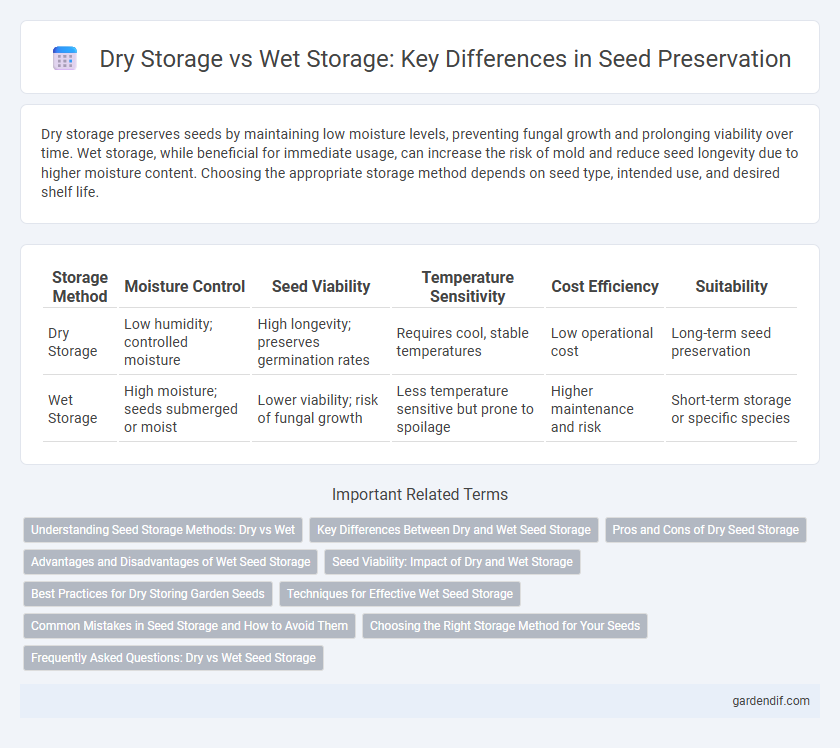
Dry storage vs Wet storage Illustration
Dry storage preserves seeds by maintaining low moisture levels, preventing fungal growth and prolonging viability over time. Wet storage, while beneficial for immediate usage, can increase the risk of mold and reduce seed longevity due to higher moisture content. Choosing the appropriate storage method depends on seed type, intended use, and desired shelf life.
Table of Comparison
| Storage Method | Moisture Control | Seed Viability | Temperature Sensitivity | Cost Efficiency | Suitability |
|---|---|---|---|---|---|
| Dry Storage | Low humidity; controlled moisture | High longevity; preserves germination rates | Requires cool, stable temperatures | Low operational cost | Long-term seed preservation |
| Wet Storage | High moisture; seeds submerged or moist | Lower viability; risk of fungal growth | Less temperature sensitive but prone to spoilage | Higher maintenance and risk | Short-term storage or specific species |
Understanding Seed Storage Methods: Dry vs Wet
Dry seed storage involves preserving seeds in low humidity environments to minimize metabolic activity and prolong viability, making it ideal for long-term conservation of genetic material. Wet seed storage, often used in short-term scenarios, maintains seeds in moist conditions or submerged in water, which can sometimes stimulate germination but also increases the risk of fungal growth and reduced shelf life. Understanding the advantages and limitations of dry versus wet storage methods is crucial for optimizing seed preservation strategies in agriculture and biodiversity conservation.
Key Differences Between Dry and Wet Seed Storage
Dry seed storage maintains low moisture content, significantly reducing seed metabolism and preventing fungal growth, thereby enhancing long-term viability. In contrast, wet storage preserves seeds in water or moist conditions, which supports immediate germination but increases susceptibility to decay and microbial contamination. Temperature control is crucial in dry storage for seed longevity, while wet storage requires frequent monitoring to avoid oxygen depletion and anaerobic conditions.
Pros and Cons of Dry Seed Storage
Dry seed storage preserves seed viability by reducing moisture content, minimizing fungal growth and metabolic activity, which enhances long-term germination rates. However, excessively low humidity can cause seed desiccation and reduce viability in some species, requiring careful control of temperature and moisture levels. Compared to wet storage, dry storage offers better stability and easier handling but demands precise environmental regulation to prevent seed damage.
Advantages and Disadvantages of Wet Seed Storage
Wet seed storage maintains seed viability by preserving moisture content, promoting metabolic activity necessary for germination. It reduces desiccation damage but increases the risk of fungal growth and microbial contamination, which can compromise seed health. Proper aeration and temperature control are critical to mitigate the disadvantages associated with wet seed storage.
Seed Viability: Impact of Dry and Wet Storage
Dry storage significantly preserves seed viability by minimizing moisture content, thereby reducing the risk of fungal growth and metabolic degradation. Wet storage conditions elevate moisture levels, accelerating seed deterioration through increased respiration rates and susceptibility to pathogens. Optimal seed viability is maintained longest under controlled dry storage environments with low humidity and stable temperatures.
Best Practices for Dry Storing Garden Seeds
Dry storage of garden seeds involves maintaining low humidity levels below 8% and temperatures between 32degF and 41degF to maximize seed viability. Using airtight containers, such as glass jars with silica gel packets, prevents moisture ingress and protects seeds from fungal growth and degradation. Labeling seeds with harvest dates and periodically checking seed condition ensures successful germination during future planting seasons.
Techniques for Effective Wet Seed Storage
Wet seed storage techniques emphasize maintaining moisture levels between 20-30% to preserve seed viability during short-term storage. Utilizing controlled environments with regulated temperature (around 15degC) and humidity prevents microbial growth and seed deterioration. Immersion in water or nutrient solutions combined with oxygen reduction methods enhances seed longevity while supporting germination potential.
Common Mistakes in Seed Storage and How to Avoid Them
Common mistakes in seed storage include neglecting moisture control, leading to mold growth in wet storage, and failing to maintain consistent low humidity in dry storage, which causes seed deterioration. Avoid these issues by using airtight containers with silica gel packets for dry storage and ensuring seeds are thoroughly dried before wet storage to prevent spoilage. Regularly monitoring temperature and humidity levels preserves seed viability and prevents bacterial contamination.
Choosing the Right Storage Method for Your Seeds
Choosing the right storage method for your seeds depends on their moisture content and longevity requirements. Dry storage is ideal for most seeds, as it prevents mold growth and extends viability by keeping seeds in low humidity and cool temperatures. Wet storage suits specific aquatic or wetland species, ensuring they remain viable in moisture without drying out, but it requires careful management to avoid rot or fungal issues.
Frequently Asked Questions: Dry vs Wet Seed Storage
Dry seed storage minimizes moisture content, effectively preventing fungal growth and prolonging seed viability for several years under controlled temperature conditions. Wet seed storage retains higher moisture levels, which can accelerate seed deterioration and increase susceptibility to mold and decay, especially if not consistently refrigerated. Optimal seed preservation favors dry storage methods to maintain germination rates and reduce risks associated with moisture-related damage.
Dry storage vs Wet storage Infographic

 gardendif.com
gardendif.com